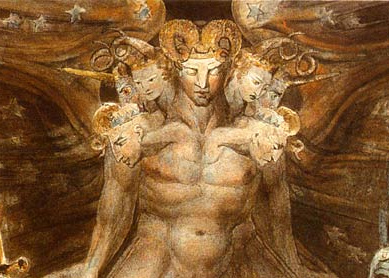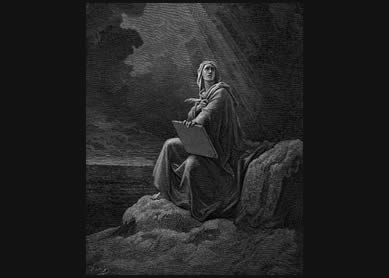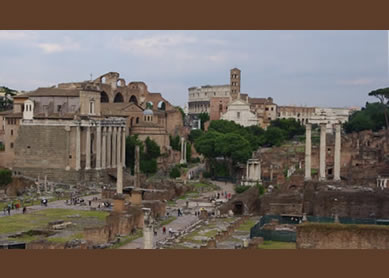The beast and its mark are the focus of horror movies about the coming of the Antichrist and countless books and pamphlets claiming to have found the key to the future. John of Patmos, however, composed Revelation toward the end of the first century C.E. as the key that would unlock the significance of what was happening all around his congregations in Asia Minor in their own time (Rev 1:4, Rev 1:11), not in some distant future. And these readers would not have had difficulty discerning what John’s beasts represented.
Who are the two “beasts”?
Rev 13:11-18 presents one scene in a larger drama. The first verses already presume familiarity with three images: the first beast, a dragon, and a lamb. John introduced the first beast in Rev 13:1-10 as an unholy hybrid of the four beasts of Daniel 7:1-8. Each of these represented one of the empires that had dominated Judea (Babylon, Persia, Greece, and Syria); John’s new beast depicted the Roman Empire, combining in itself all the power, lands, wealth, and evils of its predecessors and celebrated in its time as a world empire. The beast’s heads were its “kings” (Rev 17:9-11)—the line of emperors beginning with Augustus. Emperor Nero’s suicide ushered in a year of civil war that threatened to bring the whole system crashing down, but this “mortal wound” was healed when Vespasian arose victorious out of those struggles and established a new dynasty, giving hope for long-term stability to those who depended on Rome’s hegemony.
The second beast rises out of the land and represents a more local power in Asia Minor, probably the provincial council responsible for promoting the worship of the emperors throughout the region. It may look innocent enough, but its speech (“like a dragon”) reveals whose agenda this beast is really advancing—it belongs not to some benign deity but to Satan, the archenemy of the monotheistic God (see Rev 12:1-13:4).
What is the “image of the beast” and the “mark of the beast”?
Since the accession of Augustus in 31 B.C.E., people throughout the eastern Mediterranean expressed their loyalty and gratitude toward the emperors in the form of worship. Many people around John’s churches, especially the local elite, thought the language of worship appropriate to the power and dignity of the world ruler enthroned in Rome. Each of the seven cities addressed by John had temples or altars dedicated to the emperors, along with cult statues. His readers would not have to look far for images of the imperial ‘beast.’ John tells an alternative story about how emperor worship came about: it’s part of Satan’s plan to deceive the world (Rev 12:1-13:4), leading people to steal the worship due the one Creator God and give it to a human being (symbolized in an idol). It’s something foisted upon the world through chicanery and coercion (Rev 13:13-15), not because the emperors truly deserve such worship.
John uses parody to expose, in his opinion, the “counterfeit” savior (the emperor, often called “savior” and “lord”) and his apostle (the local provincial council). He contrasts a vision of the beast’s idol surrounded by its worshipers, marked on their foreheads or forearms with the “number of the beast,” or 666, with the vision that immediately follows in Rev 14:1-5—of the Lamb (the victorious Christ) surrounded by those who have God’s seal upon their foreheads and who worship around God’s throne.
Essentially, the mark and the seal are about each person’s master: God or the Roman emperor, who is Satan’s pawn. Worship reveals one’s allegiance, and, in the cosmic war between God and Satan, there is no room for trying to form dual allegiances. There were indeed advantages to participating in emperor worship. It was difficult to get a piece of the Roman pie without doing so (Rev 13:16-17). It would have been much safer for Christians to go with the flow. Worship—loyalty to the Roman state or to the kingdom of God—was indeed a life-or-death issue, but John’s vision tries to show just how much more was at stake for those who failed to keep God’s commandments, the first of which deals with whom to worship, and the second of which deals with not worshiping any images (Rev 13:15; Rev 14:6-7, Rev 9-11). According to Revelation, worship demonstrates that God wants more for the people of the world than is possible under human empires.
Bibliography
- Kraybill, Nelson. Apocalypse and Allegiance: Worship, Politics, and Devotion in the Book of Revelation. Grand Rapids, Mich.: Brazos, 2010.
- Koester, Craig. Revelation and the End of All Things. Grand Rapids, Mich.: Eerdmans, 2001.
- Spilsbury, Paul. The Throne, the Lamb & the Dragon: A Reader’s Guide to the Book of Revelation. Downers Grove, Ill.: InterVarsity, 2002.





